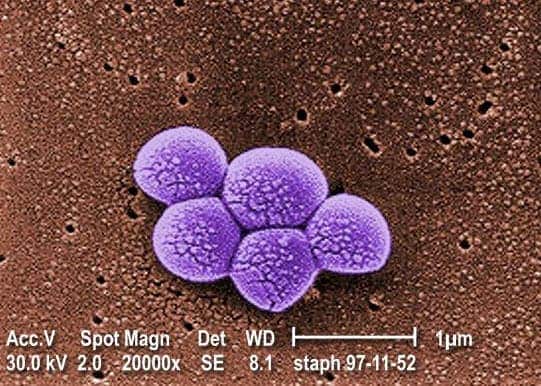A new study from Karolinska Institutet found that methicillin-resistant Staphylococcus aureus (MRSA) bacteria are kept in check, on our skin, by a type of immune cell known as a neutrophil.

Image credits Public Health Image Library (PHIL).
The findings can help explain why some people only carry the superbug for short periods without contracting an infection.
“The skin is an incredibly dynamic biological environment where immune cells and microbes stand-off against one another to maintain some kind of equilibrium, a fraught peace,” says Keira Melican, senior researcher at the Department of Neuroscience, Karolinska Institutet, who led the study.
“Breaks in these equilibria typically lead to bad outcomes for humans, and understanding how this process works on the skin could have an impact on how we prevent and treat skin infection in the future.”
The authors developed a “humanized” mouse model by grafting human skin onto mice — this helped them look at how human tissues would respond in vivo. After colonizing the skin with MRSA, they explain, neutrophils were recruited to the skin, where they destroyed the antibiotic-resistant bacteria.
While the experiment sounds a bit… cruel, it was designed this way to address the main limitation of animal models as proxies for humans: their biology is different from ours on many (if not all) levels. The team needed to incorporate human tissues into the model animal to get a more accurate representation of how a human body would react to the bacteria.
So why go through all this trouble? Staphylococcus aureus is a very common species of bacteria: up to 30% of all humans carry it long-term, at any given time, generally in the upper respiratory tract and on the skin. It’s generally not very damaging or deadly, although it can cause some skin infections or food poisoning among a few other problems.
However, and this is a big however, several strains of S. aureus are rapidly becoming resistant to most (sometimes all) our antibiotic courses, especially in hospital settings. Known as MRSA, infections with such strains are life-threatening and very difficult to treat. The new study aims to find new ways of containing or combating MRSA by understanding how our natural immune response helps keep it at bay.
“We hope that our humanised skin model will help make sure that our results are relevant to humans, and not just mice,” says Melican.
The paper “Neutrophil recruitment to noninvasive MRSA at the stratum corneum of human skin mediates transient colonization” has been published in the journal Cell Reports.









